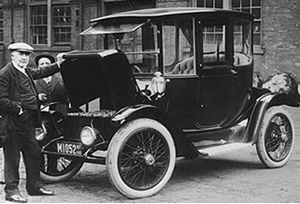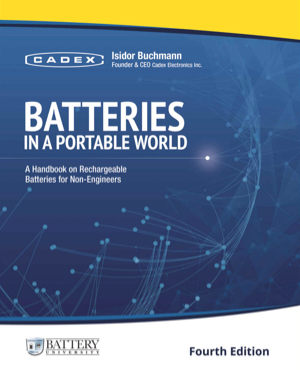Few other products have such stringent requirements
Society seeks liberation from the dependence of oil and gravitates towards the battery as the ideal green solution for our energy needs. While this crusade is noble and right, the battery has not yet matured to take on this important responsibility. Pushing the boundaries of the battery reminds scientists of the many limitations this electrochemical power source presents. The battery is a feeble vessel that is slow to fill, holds limited energy, runs for a given time like a wind-up toy and has a defined life span of only a few hundred discharge-charge cycles before it becomes a nuisance.
In many ways, the battery resembles human qualities. It needs recuperation from the daily travail with a long and restful charge, then delivers for a time and quits on its own terms. Some batteries need as much charging time as they deliver, and there are similarities with growing teenagers (the author raised five). It’s as if the battery has a mind of its own and decides when the time is right to deliver and when to stop walking.
In an age where surprise developments flash before our eyes daily, the battery seems to make the exception of being late. Improvements made since the commercialization of lithium-ion in 1991 by Sony are pale compared to the vast advancements in microelectronics. Whereas the Moore’s Law doubled the number of transistors in an integrated circuit every two years, the capacity gain of Li-ion during the last two decades was only about eight percent per year. There will be further improvements but not without potential higher fragility, lower durability and shorter life.
The battery consists of two electrodes that are isolated by a separator that is soaked in electrolyte and acts as catalyst much like the ham and cheese in our sandwiches. Progress is being made, however the lithium-air proposed in the 1970 with a potential specific energy resembling gasoline is delayed due to stability and air-purity issues as the battery breaths oxygen from the air. The promising lithium-metal introduced in the 1980s still grows dendrites, leading to possible violent reactions if an electrical short develops. The lithium sulfur may be closer but scientists must still resolve the short cycle life. The Redox-flow battery promises a solution for large battery systems by pumping fluids from external tanks through a membrane that resembles a battery. There is a glimmer of hope by coating the anode of Li-ion with graphene, a layer that is only one atom thick. This is said to quadruple the energy density and Elon Musk of Tesla is taking note. It must be uttered that experiments with graphene have been in the works for some time. Graphene also shows promise for other developments, including the supercapacitor and solar panels. Immerging batteries will take four years to commercialize, and there are no heavy lifters on the homerun.
The Joint Centre for Energy Storage Research (JCESR) is more optimistic. The organization gathered the brightest minds from US national laboratories, universities and private enterprises to improve the battery. With a grant of $120 million from the US Department of Energy, JCESR wants to develop a battery that is “five times more powerful and five times cheaper in five years.” They call this the 5-5-5 Plan. “Can politicians create a better battery by throwing a ton of cash at it,” we ask? Battery development has been methodical and adding fertilizer might boost the growth for a time, but too much can poison a tree.
Toyota is also in the race for a new battery. It will be called the “Sakichi battery” after Sakichi Toyoda, the inventor of Japan’s first power loom (Surname Toyoda is spelled with a d.) Sakichi is sometimes called the father of the Japanese industrial revolution. It is said than in 1925, Sakichi Toyoda promised a yet-to-be-claimed prize of 1 million yen for a storage battery that produces more energy than gasoline. To qualify for the price, the Sakichi battery must also be very durable and quick to charge.
There is no shortage of battery breakthroughs but most fall silent. Some claims sound so promising that one questions the credibility. It’s no secret that researchers prefer publishing the positive attributes while keeping the negatives under wraps. Elon Musk, CEO of Tesla Motors, stated in June 2014 that he had not seen a battery breakthrough that is better than what Tesla deploys in their EVs. The reason for the low success is meeting a minimum of 10 basic requirements, which are: [1] high specific energy for long runtimes, [2] high specific power for load currents, [3] affordable cost, [4] long life, [5] high safety, [6] wide operating range, [7] no toxicity, [8] fast charging, [9] low self-discharge and [10] long shelf life.
While most batteries for consumer products are lithium cobalt oxide (LCO) to attain a long runtime, industrial uses prefer the more rugged lithium manganese oxide (LMO) to achieve high load capabilities and long cycle life. Much effort is devoted to find a better battery for the electric vehicle (EV) and two philosophies have immerged, the Tesla Model and the BMW Model.
The Tesla Model S uses lithium nickel cobalt aluminum oxide (NCA) that delivers an ultra-high specific energy of 248Wh/kg. To protect the battery from over-loading and keeping it cool at highway speed, Tesla over-sizes the pack by a magnitude of 3–4 compared to the kWh rating of the BMW i3 and other EVs. At 85kWh, the battery in the S-85 is said to achieve a driving range of up to 424km (265 miles) between charges, but the pack is expensive and heavy and the extra weight increases energy consumption. The Tesla S-85 draws roughly 240 Watt/hours per km (360 Watt/hours per mile).
The BMW i3, in comparison, uses the more conservative LMO that produces only 120Wh/kg and the 22kWh pack provides a driving range of 130–160km (80–100 miles). To compensate for the shorter driving range, the i3 also offers the REX, an optional gasoline engine that can be fitted on the back. The BMW i3 is lighter than the Tesla S-85 and has one of the lowest energy consumptions in the EV family. It only draws 160 Watts/hours per km (260 Watt/hours per mile).
What remains unanswered is the longevity of the EV batteries. “Will they last as long as the car?” is the question because a battery replacement can cost as much as an economy car with combustion engine. All EV manufacturers must provide an eight-year warranty or a mileage limit. Tesla believes in their battery and offers unlimited mileage.
The electric vehicle is not new. Most cars in the late 1800s and early 1900s ran on batteries. At the turn of the century, the car buyer had three choices of propulsion system to select from. They were electric, steam and internal combustion (ICE) engine, of which the ICE was the least common. Figure 1 shows Thomas Edison with his 1914 Detroit Electric model. Most electric cars ran on lead acid batteries and Mr. Edison felt that nickel-iron was superior and promoted his more expensive batteries.
 | Figure 1: Thomas Edison with a 1914 Detroit Electric, model 47 Physicians and women were the main buyers of EVs. Thomas Edison, John D. Rockefeller, Jr. and Clara Ford, the wife of Henry Ford, drove Detroit Electrics. Courtesy of National Museum of American History |
The electric cars appealed to the upper class and the vehicles were finished with fancy interiors. Although higher in price than the steam and gasoline-powered vehicles, the wealthy chose the electric car for its quiet and comfortable ride over the vibration, smell and maintenance-prone gasoline-powered vehicles. Best of all, the electric car did not require gear-changing and manually engine-cranking, a task the upper class did not want to be seen doing. Since the only good roads were in town, the limited range of the EV was no problem and most of the driving was local commuting. With the invention of the starter engine in 1912, the market gravitated towards the ICE and the EV fell out of favor in the 1920s.
Summary
Consumers are generally satisfied with the battery performance in their portable devices. Today’s battery technology also serves power backup reasonably well, but large lead acid systems are not well suited for systems needing continuous cycling.
There are limitations as to how far the battery can go and the EV sets the threshold. It makes little sense to use batteries to power trains, ships and airplanes. Competing against the mighty oil with a net calorific value that is 100 times higher than the battery is a challenge. Conversely, petroleum cannot touch the battery that is clean, quiet, small, and has an immediate start-up with the flick of a switch.
Batteries have a defined role and incremental improvements will secure more of what is so strongly entrenched in the seemingly endless flow of cheap fossil fuel. While oil is virtually free, society pays a price for burning it. Damage to the environmental and rising health issues have become more evident. But we cannot be so naïve as to think that batteries will solve our energy problem. The West is drunk with cheap oil and any deviation requires a change in our extravaganza, and few are willing.
About the Author
Isidor Buchmann is the founder and CEO of Cadex Electronics Inc. For three decades, Buchmann has studied the behavior of rechargeable batteries in practical, everyday applications, has written award-winning articles including the best-selling book “Batteries in a Portable World,” now in its third edition. Cadex specializes in the design and manufacturing of battery chargers, analyzers and monitoring devices. For more information on batteries, visit www.batteryuniversity.com; product information is on www.cadex.com.
© Isidor Buchmann, Cadex Electronics Inc.

Comments
Looking for comments from the previous website?
Comments from the previous website are not compatible with our new commenting system but we have preserved them so our users can still reference and make use the information in them.
